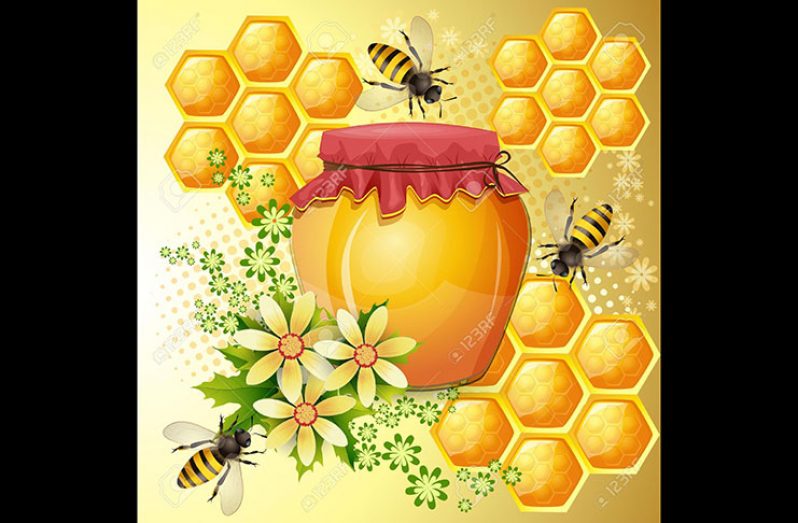—to help meet foreign demand for local honey
THE Guyana Livestock Development Authority (GLDA) is calling on the public to help scale-up production in our fledgling honey industry by getting involved in apiculture.Acting Deputy Chief Executive Officer, Michael Welch said the GLDA would welcome expressions of interest in beekeeping from members of the public as there is a great demand for local honey on the international market, which is hard to meet, given the few hundreds of people currently involved in apiculture.
Welch told the Guyana Chronicle last week that close to two years ago, there were people coming here from as far off as North Africa looking to buy honey.
“We had people coming from one of these North African countries looking for the honey, and when they tasted it, they said that it is the best they’ve ever tasted,” Welch said, adding:
“They use honey as a staple: They use honey and rice, honey and bread, honey and everything, but we need to scale-up to capture those markets, because they were looking for a 40-foot container every month. “They’re not playing; this is serious business, so there is tremendous potential.”
NATIONAL BEE ACT
And, in an effort to buck the trend among some local honey producers to “stretch” their product by adding “sugar-water”, the GLDA is currently finalising the drafting of a National Bee Act. This Act, Welch said, will not only apply to regulating the rearing of bees here, but special emphasis will also be placed on maintaining a pure quality of honey, and the geographical zoning of apiculture, among other related matters.
“Legislation is part of the Guyana Livestock Development Authority’s 2017 work programme,” Welch said.
As he went on to explain, “What is supposed to happen, and that is what we’re moving towards, is legislation regulation, so that we can test to make sure that when you go to the shop and you buy honey, you have pure honey.
“So we have to work very closely with Food and Drugs to ensure that consumers are not duped.”
At the moment, he said, the final touches are being made to the drafting of the Bill preparatory to it being tabled in the National Assembly, while work with the Export Credit Agency (ECA) and the Food and Agricultural Organisation (FAO) is ongoing in terms of putting together the document, which will also address exportation, the setting of hives and dealing with honey.
ZONING
And given the tendency among bees to create hives in densely populated areas, which can pose a threat to humans and animals, Welch said the GLDA, which has established a special unit to deal with apiculture, is moving to recommend and encourage beekeeping in specific zones in the hinterland and other less populated areas.
“We need to zone,” Welch said. “If we can get people to zone in terms of putting them where there are minimal chances of contact, it is better… but the key is education.”
In terms of raising awareness, Welch said the organisation has already begun its countrywide education campaign in schools and communities, and has even assisted several individuals and organisations in establishing apiculture businesses.
Among areas best recommended for raising bees are Regions Eight (Potaro-Siparuni); Nine (Upper Takutu-Upper Essequibo); and Seven (Cuyuni-Mazaruni), and on the Soesdyke-Linden Highway in Region Four (Demerara-Mahaica).
“Those areas are ideal for beekeeping, because of the population and the chance of no contact,” Welch said.
“And it’s a very good way of making an income. If the honey is properly labelled, like ‘organic honey’ and the like, you get them into certain niche markets,” he added.
COSTING
To get an apiary up and running, Welch said, would cost around $50,000, and includes providing suit, hive, smoker and bees. Training is not a problem, he said, as the organisation provides that free of cost. The programme is also ably supported by the Guyana Apiculture Society, the chairman of which is veteran apiculturist, Mr Neil Grant.
There’s also a school programme for aspiring young apiculturists. “We have a school programme,” Welch said, “where we try to have young people become involved in beekeeping. We also work in communities with the women farmers and single parents. And in the hinterland, we try to work with the Amerindian communities, because they have a large expanse of vegetation that could lend itself very readily to beekeeping.”
Products from bees include pollen, royal jelly and wax, and according to Welch, more than 70% of the crops depend on bees.
Commercial apiculture is profitable, with one large rum bottle of honey being sold at around $1200 to $1500. “Once you set up this hive, is money coming in all the time,” he said, adding that a strong hive is capable of producing five to eight gallons of honey annually.
The market price per gallon is $10,000.




.png)









